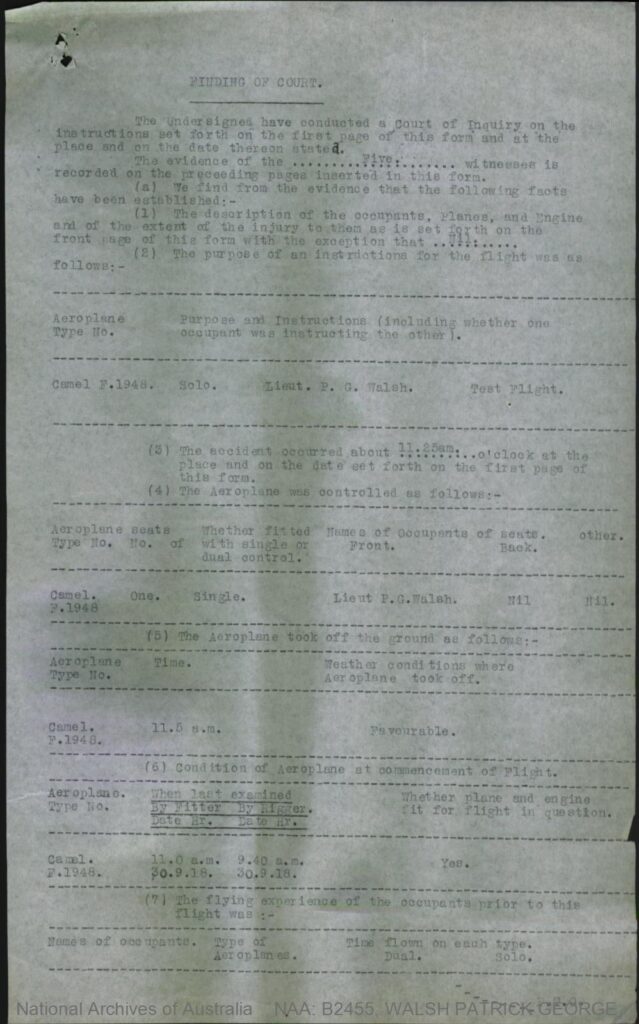Patrick George Walsh was a bright young man from Toowoomba, who worked as a bank teller when he enlisted in 1915. He had some years’ experience in the citizens’ forces and went on to receive a commission and serve as an officer in three different units. Patrick was born at Cunnamulla in the south-west of the state, the son of Richard and Mary Walsh. He moved to Toowoomba as a child where he was educated at the Christian Brothers College (now St Mary’s) and Toowoomba Grammar School. On his enlistment he gave his address as “Goodwood”, Goodwood Street, Newtown, Toowoomba.
Patrick was 19 years and 4 months of age when he enlisted, in Toowoomba, on 5 October 1915. He was 5’10” tall and weighed 149 pounds. His denomination was RC. Patrick sailed as a private aboard the A16 Star of Victoria from Sydney on 31 March 1916. His unit, the 16th Reinforcements of 9th Battalion landed at Port Said in Egypt but did not immediately join the battalion as it re-built after the Gallipoli campaign. Patrick moved on to France and was training at the base at Etaples when he received his posting to join the battalion on the front-line at Pozieres.
Patrick was an enthusiastic soldier and evidently displayed leadership qualities. He was detached from the unit on 2 October to attend officer training in England. He joined the 4th Officer Cadet Battalion at Oxford where he undertook a three-month course to gain his commission. After a furlough in England he travelled back to France as a supernumerary 2nd Lieutenant until he joined the 25th Battalion, another battalion from Queensland that included a large number of Toowoomba men in its ranks. Patrick served with the 25th from 21 February to 5 June 1917. This time included the battalion’s participation in the Battle of Bullecourt. In April and May the 25th lost about 40 killed and 200 wounded; Patrick survived unscathed and was transferred back to his old battalion, the 9th, as a full lieutenant on 20 June 1917.
Patrick served with the battalion for the remainder of the calendar year. His experience demonstrates the health hazards faced by soldiers beyond the risks of actual combat. He was laid up with diarrhoea that lasted several weeks; and needed urgent dental work in England. He survived the terrible fighting at Ypres in the autumn where many units lost over half their strength.
Patrick’s career took its final radical turn on 19 December 1917 when he transferred to the Australian Flying Corps (AFC). He would now become a flying officer. He was transferring from one extremely dangerous occupation to an even more dangerous one. For the next several months Patrick trained at Reading and Wendover in England until he graduated as a “flying officer pilot”. In mid-1918 he moved on to continue his training at Leighterton in Gloucestershire where the AFC had a facility for preparing pilots for front-line operational conditions using front-line aircraft.
On 30 September 1918 Patrick was practising a ground-attack manoeuvre; his plane pulled out of a dive attack on a target, but as he began to climb witnesses saw the plane turn towards the ground in what the report later described as an “engine spin”. The plane, a Sopwith Camel, crashed into the ground and Patrick was killed instantly. The aircraft was totally destroyed. A court of inquiry conducted a few days later attached no blame to the pilot. On 3 October Patrick was buried in the local churchyard. He is one of 23 flying corps men, all Australians, to be buried at Leighterton. Another of these men was Tom Clutterbuck, who is also on the Mothers’ Memorial.
An extensive correspondence flowed between Patrick’s family and the army. Writing under their business letterhead of Walsh & Co Agricultural Seedsmen of Toowoomba, Richard and Mary Walsh inquired into all aspects of Patrick’s service. They were given detailed information of his funeral with full military honours, performed by Catholic chaplain, Fr. K.D. Norman, attended by officers from AIF HQ, and the Russell family, relatives from London. Patrick was 22 years of age when he died.
Toowoomba Grammar School Archive Records State that he started school on 1st February 1914 and left 31st December 1914. He played in the 1st XV Rugby in 1914. The School Magazine of November 1918 stated, ‘WALSH. GEORGE W.-Son of R. Walsh, of Toowoomba Flight-Lieut.-At School and in the XV and Athletic team in 1913. Supposed died as result of accident. The magazine also had a photo of him.
It is interesting to note that there were 235 accidents in Britain from 1 September to 11 November 1918 of pilots and mechanics – Fatal Accidents in Britain
External Links:
Australian National Archives Military Records
AWM4 AIF unit war diaries 8/11/5 8TH AFC
Australian War Memorial Honour Roll

Sopwith Camel F1 – 150HP A.R.I. Engine Type 2F

PG Walsh may have worn one of the AFC badges

Court of Enquiry – witness statements- NAA

Court of Enquiry notes 1- NAA

Court of Enquiry 3 – NAA

Letter to family on Patrick’s burial – NAA




